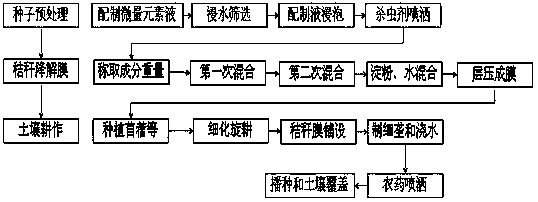Method for directly sowing and planting rice
A rice seed and rice technology, applied in the fields of rice cultivation, seed immunization, seed and rhizome treatment, etc., can solve the problems of uneven emergence of rice seedlings, insufficient labor force, and poor control of water irrigation, so as to improve the ability of resistance to diseases and insect pests, The effect of increasing plant spacing and facilitating field management
- Summary
- Abstract
- Description
- Claims
- Application Information
AI Technical Summary
Problems solved by technology
Method used
Image
Examples
Embodiment 1
[0017] Weigh 100 kg of water, 0.15 kg of boron fertilizer, 0.15 kg of zinc fertilizer, 0.15 kg of copper fertilizer, and 0.15 kg of iron fertilizer to prepare a trace element solution; weigh 100 kg of water and 0.45 kg of matrine to prepare an insecticidal solution; Place in clean water to remove the inferior seeds, then soak in the prepared trace element solution, soak for 5.5h, place in a drying box for low-temperature drying, at a temperature of 15℃, for 1.5h, and then spray the Kutanin 0.45% solution . According to the mass ratio, weigh out 67kg of straw powder, 6kg of starch, 3.5kg of polylactic acid, 7kg of fiber, 1.5kg of lignin, 4kg of baking powder, 1.5kg of cellulolytic bacteria, 1.5kg of phosphate fertilizer, and 1.5kg of pyrite fertilizer. The weight of each component; first add straw powder, polylactic acid, hemp fiber, and lignin into the mixing tank, rotate at 90 rpm, and stir for 1 hour; then, add baking powder, cellulolytic bacteria, phosphate fertilizer, and p...
Embodiment 2
[0019] Weigh 100 kg of water, 0.2 kg of boron fertilizer, 0.2 kg of zinc fertilizer, 0.2 kg of copper fertilizer, and 0.2 kg of iron fertilizer to prepare a trace element solution; weigh 100 kg of water and 0.5 kg of kutangin to prepare an insecticidal solution; Put in clean water to remove the inferior seeds, then soak in the prepared trace element solution, soak for 5.5h, put in a drying box for low-temperature drying, at a temperature of 15℃, for 1.5h, and then spray 0.5% saline . According to the mass ratio, weigh out 69kg of straw powder, 8kg of starch, 4.5kg of polylactic acid, 9kg of fiber, 2.5kg of lignin, 5kg of baking powder, 2.5kg of cellulolytic bacteria, 2.5kg of phosphate fertilizer, and 2.5kg of pyrite fertilizer. The weight of each component; first add straw powder, polylactic acid, hemp fiber, and lignin into the mixing tank, rotate at 90 rpm, and stir for 1 hour; then, add baking powder, cellulolytic bacteria, phosphate fertilizer, and pyrite Fertilizer, stir...
PUM
 Login to View More
Login to View More Abstract
Description
Claims
Application Information
 Login to View More
Login to View More - R&D
- Intellectual Property
- Life Sciences
- Materials
- Tech Scout
- Unparalleled Data Quality
- Higher Quality Content
- 60% Fewer Hallucinations
Browse by: Latest US Patents, China's latest patents, Technical Efficacy Thesaurus, Application Domain, Technology Topic, Popular Technical Reports.
© 2025 PatSnap. All rights reserved.Legal|Privacy policy|Modern Slavery Act Transparency Statement|Sitemap|About US| Contact US: help@patsnap.com

